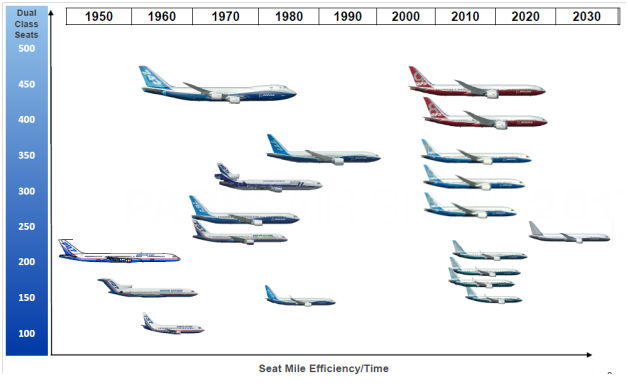Leeham News and Analysis
There's more to real news than a news release.
 Leeham News and Analysis
Leeham News and Analysis
- Does an A220-500 need a new wing and engines? Part 4. July 3, 2025
- GE testing of giant GE9X engine aims for maturity at entry into service June 30, 2025
- Bjorn’s Corner: Air Transport’s route to 2050. Part 28. June 27, 2025
- Parent agency, FAA often at odds as politics outweighs safety June 26, 2025
- Electric Flight and the Ugly Duckling June 25, 2025
Boeing ponders restart of 767-300ER passenger line
Oct. 19, 2017, © Leeham Co.: Boeing is nearing a decision whether to restart the 767-300ER passenger line, LNC has learned.
The company is in discussions for 50-60 aircraft, market intelligence indicates.
Boeing declined comment, saying it does not discuss conversations with customers.

United Airlines Boeing 767-300ER. Photo via Google images
But sources indicate that the prospect of restarting the 767-300ER passenger line could serve as interim lift until the prospective entry-into-service of the Boeing New Midrange Aircraft, now commonly called the 797, for the Middle of the Market sector.
LNC on Aug. 14 speculated that relaunching the 767-300ER could be a good tactical move on Boeing’s part.
Posted on October 19, 2017 by Scott Hamilton
Assessing the 25 YOA aircraft factor
Subscription Required
Introduction
Sept. 21, 2017 © Leeham Co.: Airbus and Boeing look ahead to 2021 and the next several years when wide-body aircraft begin turning 25 years old to spur orders for this sector.
Boeing specifically points to this period as one reason for the announcement last week that it will boost production of the 787 to 14/mo beginning in 2019.
Summary
- There already are 1.4 times more wide-body airplanes scheduled for delivery in 2021-2025 than there are aircraft turning 25 years old.
- The next surge in aging aircraft comes ~2030.
- Middle of the Market aircraft isn’t factored in.
Posted on September 21, 2017 by Scott Hamilton
Airbus, Airlines, American Airlines, Boeing, Emirates Airlines, Etihad Airways, Middle of the Market, Premium, United Airlines
767-300ER, 777 Classic, 777X, 787-8, A330-200, A330-800, A350, A350-1000, Airbus, airlines, American Airlines, Boeing, Emirates Airline, Etihad Airways, NMA, United Airlines
Pontifications: JADC 20-year forecast: VLA, NMA and other data
July 24, 2017, © Leeham Co.: The Japan Aircraft Development Corp (JADC) just published its 2017-2037 jet and turboprop forecast. JADC forecasts a demand for 33,336 jet airliners and some 2,000 turboprops.
JADC is partly owned by Mitsubishi, which is developing the MRJ70/90 and which is on several Boeing programs.
I like the JADC forecast because it segments the seating categories in more detail than Airbus and Boeing and somewhat differently than Bombardier and Embraer.
I also view JADC as having less of an axe to grind than the Big Four OEMs.
A couple of quick take-aways:
Posted on July 24, 2017 by Scott Hamilton
Airbus, ATR, Boeing, Bombardier, CSeries, E-Jet, Embraer, Middle of the Market, Mitsubishi, MOM, Paris Air Show, Pontifications, Sukhoi
Air Canada, Airbus, ATR, ATR 42, ATR-72, Boeing, Bombardier, Cebu Pacific, CS100, E190, Embraer, JADC, Japan Aircraft Development Corp., Mitsubishi, MRJ70, MRJ90, New Midrange Aircraft, NMA, SSJ100, Sukhoi
Business case for NMA remains uncertain
Subscription Required
Introduction
July 17, 2017, © Leeham Co.: We’re half way through 2017. Boeing reported orders through July 11, a week ago. Airbus won’t update its July orders until the end of the month.
Through July 11, Boeing reported 116 net wide-body orders: 15 for the 767, 33 for the 777 and 75 for the 787. Net cancellations of -7 for the 747 are included in the net 116 figure.
The 15 767s were not commercial models, however, but 767-2C tankers for the USAF.
Over at Airbus, none of China’s 40 commitments announced July 5 for 40 A350s are in the June summary, and won’t be in the Orders tally until the commitments turn into firm orders. Through June, airbus had net 26 widebody orders: three A330-200s and 29 A350-900. There were cancellations of four A330-800s and two A380s.
If the 40 China A350s were included, this would bring Airbus to 66 widebody orders, still well short of Boeing’s YTD figure.
Summary
- Airbus product gap widens as A330-200/800 stalls.
- Boeing 787 strength comes from 787-9; 787-8 remains minor player.
- Middle of the Market business case still unproved.
Posted on July 17, 2017 by Scott Hamilton
Developing Boeing’s airplanes
 June 21, 2017, © Leeham Co.: “It’s all about continuing the development strategy since thirty years” said Mike Delaney, VP of program development for Boeing. “It’s about continuing the development strategy for 30 years producing super efficient twins that support point-to-point networks.”
June 21, 2017, © Leeham Co.: “It’s all about continuing the development strategy since thirty years” said Mike Delaney, VP of program development for Boeing. “It’s about continuing the development strategy for 30 years producing super efficient twins that support point-to-point networks.”
Delaney made the remarks at the Paris Air Show about developing the 737 MAX 10 and the NMA (New Medium size Airplane).
Figure 1 shows the Boeing products over the years, with the 737 MAX 10 and the NMA filling the gap between 180 and 270 two class seats (note the 748i is no longer part of the chart). The MAX 10 is in place and a tentative NMA is showing the way into the next decade. Read more
Posted on June 20, 2017 by Bjorn Fehrm
Boeing has MOM sector “crisis,” says Leahy
June 5, 2017, © Leeham Co.: Boeing has a “crisis” in the Middle of the Market airplane sector, declared Airbus’ top salesman.

John Leahy, COO Customers, Airbus.
Development of the 737 MAX 10, which is expected to be launched at the Paris Air Show in two weeks, won’t solve it, either.
John Leahy, COO Customers for Airbus, made the remarks today during a small press event at the Annual General Meeting of IATA in Cancun, Mexico.
Posted on June 5, 2017 by Scott Hamilton
Interest seen in Boeing’s “797,” says lessor
May 16, 2017, © Leeham Co.: Air Lease Corp., one of the world’s leading lessors, sees

John Plueger, CEO of Air Lease Corp.
a “quite a bit” of interest from its customers in the prospective Boeing Middle of the Market aircraft, says its CEO, John Plueger.
Speaking at the Airfinance Journal conference in New York today, Plueger acknowledged with some push from moderator Mark Streeter of JP Morgan that pricing needs to be in today’s dollars in the $70m-$75m range.
Posted on May 16, 2017 by Scott Hamilton
How Airbus can kill the Boeing 797

Artisit concept of the Boeing 797. Rendering via Google images.
May 10, 2017, © Leeham Co.: Airbus can kill the business case for the prospective Boeing 797, the New Midrange Aircraft also known as the Middle of the Market Airplane,
- Reuter’s Tim Hepher has this story.
- CNN’s Jon Ostrower has this story.
All it has to do is move first, instead of waiting for Boeing to launch the 797, something considered likely next year.
If Airbus launched what is commonly called the A322, a larger, longer-range version of the A321neo, the new version would become a true replacement for the Boeing 757, meet economics of the smaller 797, which has a working title of the 797-6, at a much lower capital cost.
Posted on May 10, 2017 by Scott Hamilton
Airbus, Boeing, CFM, GE Aviation, Middle of the Market, MOM, Pratt & Whitney, Rolls-Royce
737-10, 737-9, 767-200, 767-300, 787-8, 797, 7M7, A321NEO, A322, Airbus, Boeing, CFM, GE Aviation, GTF, LEAP, MOM, NMA, Pratt & Whitney, Rolls-Royce, Safran
7M7 is key to Boeing’s future
Subscription Required
Introduction

An enthusiast’s concept of the Boeing 797. Image via Google.
April 24, 2017, © Leeham Co.: Boeing faces growing challenges this year as airplane sales slow, production of the 777 Classic declines, its new Global Services unit prepares to formally launch and a decision whether to authorize a sales offering for the New Midrange Airplane looms.
We’ve spent a lot of time covering slowing sales and declining 777 production. Tomorrow, we’ll have a special report on the ambitious Global Services strategy.
We’ve also spent a lot of time on the Boeing NMA. LNC’s Bjorn Fehrm last week presented number three in a paywall series on the NMA, looking at it from a technical viewpoint. We’ll take a look at it from a strategic point of view today.
Summary
- There is a demand for the NMA that is commercially viable.
- Middle of the Market sector is larger than typically defined.
- 7M7 is key to Boeing’s future.





Boeing’s tactical option for MOM sector
Subscription RequiredIntroduction
Aug. 14, 2017, © Leeham Co.: It’s not a done deal yet—the business for the so-called Boeing 797 remains a challenge. But the consensus is that Boeing will launch the program next year, for an entry-into-service around 2025.
Boeing 797 concept. Source: Boeing.
Yet there are airlines that say they don’t want to wait that long for a new airplane.
What are their choices?
Read more
7 Comments
Posted on August 14, 2017 by Scott Hamilton
air force tanker, Airbus, Airlines, American Airlines, Boeing, Bombardier, CFM, Delta Air Lines, GE Aviation, Leasing, Leeham News and Comment, Middle of the Market, MOM, Pratt & Whitney, United Airlines, US Airways
737-10, 737-9, 757, 767-200ER, 767-300ER, 777, 777-300ER, 797, A330-200, A330-800, Airbus, airlines, American Airlines, Boeing, Delta Air Lines, Japan Air Lines, Middle of the Market, MOM, New Midrange Aircraft, NMA, United Airlines